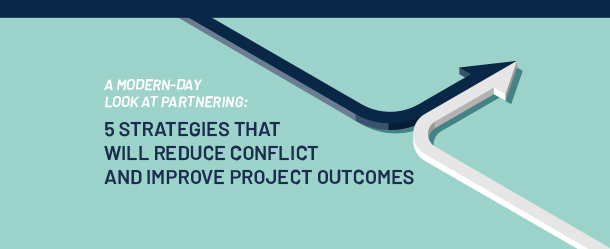



As construction management professionals and consultants, it’s our business to think about how people and processes fit together to achieve the best results. Many of us got into this industry because we have a passion for building something bigger than us. Better buildings. Better infrastructure. The power to impact cities and communities for years to come.
With this in mind, there is nothing quite as rewarding as delivering a successful project with a successful team. And, as with any team environment, this is not always an easy task. We know that project teams are not always formed out of choice, project stakeholders come together at all stages, and projects are delivered by a variety of different delivery methods.
Despite these challenges, there is one aspect of a successful team that is constant: a shared, collaborative culture and a commitment to project development and problem resolution regardless of the contract delivery method used. This is where the concept of Partnering comes in.
In the design and construction industry, Partnering is a formal, facilitated management process in which all project stakeholders voluntarily agree at the outset of a project to adopt a cooperative, team-based approach in order to eliminate or reduce conflicts and claims, and enhance job satisfaction and successful project outcomes.
The concept of Partnering made its debut in the late 1980s in response to a significant increase in conflicts, claims, and litigation among owners, architects, and contractors. Since then, several management consulting firms, federal agencies, and professional organizations have embraced and helped define the Partnering process.
According to the International Partnering Institute (IPI), Partnering:
Despite these benefits, the momentum for Partnering subsided from its initial introduction to the industry, and its definition and use have taken many different forms. Our research has revealed that no two owners are conducting Partnering the same way. Some mandate Partnering for all of their projects, while others conduct Partnering on projects of certain size, complexity, or visibility. Others differ in the formality of the partnering agreement, the frequency of meetings, and the players involved.
As technology and innovation have changed the way construction projects are delivered, it is interesting to note that the concept of Partnering serves as a foundation to many of the advances in construction project approaches we are seeing today – such as integrated project delivery (IPD), Lean, Public-Private Partnerships (P3), and design-build. All of these enhance the premise of Partnering by way of shared risk, schedule and material coordination, improved project performance, and a focus on people.
Successful Partnering is when the unique goals and objectives of every team member are recognized and supported by the rest of the team. Through a shared culture, a process is developed that enables the team to meet at regular intervals to co-create project goals and accountability to those goals, establish a dispute resolution procedure, identify issues and resolve them, and identify opportunities to improve project outcomes. By first building a shared, agreed-upon culture, Lean processes and various collaborative delivery methods are more successful.
We are seeing a resurgence of Partnering but now we are viewing it through a different lens. It’s not collaboration just for collaboration’s sake. It’s not a one-off event but instead a means of improving the project that extends well beyond the initial Partnering session. It involves face-to-face, regular engagement and includes tangible, actionable management techniques to help avoid problems, solve problems, or shrink problems.
We see Partnering as a platform to implement and reinforce proven management techniques that will provide a benefit to the project in their own right. Conducting Partnering in this way maximizes its benefits and reinforces its importance. Utilizing Partnering sessions for one or more of the following will provide opportunities for project teams to cement their collaborative relationships by addressing substantive project issues:
As seasoned project and program managers, we at MBP know how important a collaborative and trusting team dynamic is to project success. We have seen how great teams deliver success even when faced with extraordinary challenges while the most straightforward of projects can hit snags when teams operate at cross-purposes.
We continue to encourage our clients to incorporate our “Modern Day Partnering” strategies (Partnering 2.0, if you will) to elevate the Partnering workshop into an opportunity to forge strong working relationships while tackling a project’s toughest issues.
Related reading: Learn more about Public-Private Partnerships (P3) delivery.
Comments